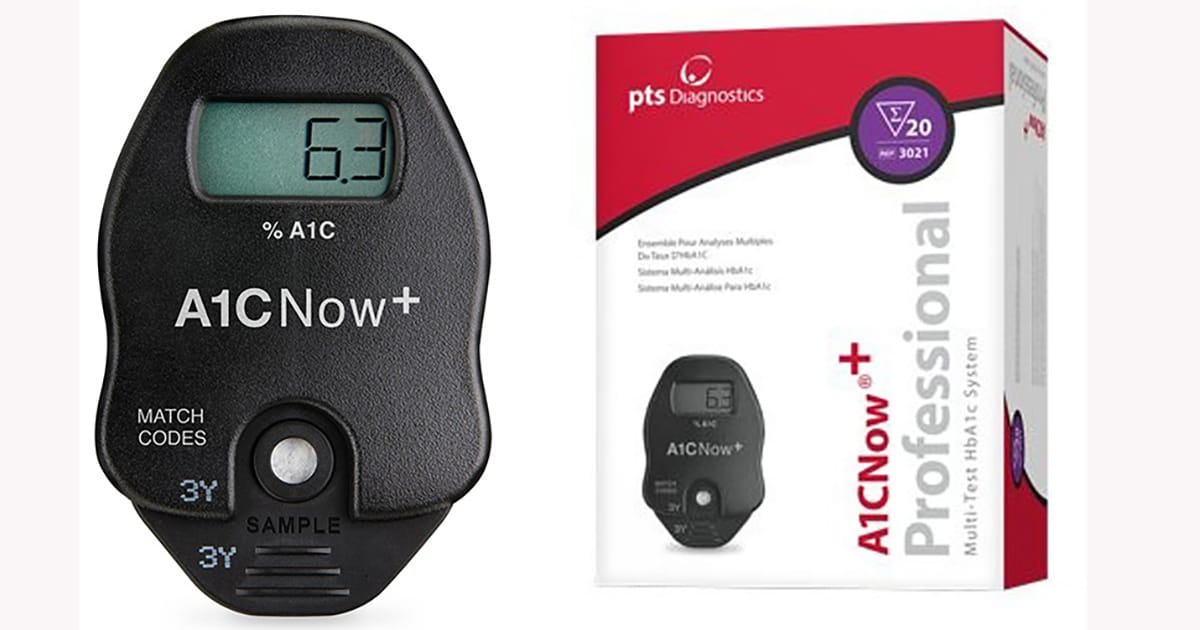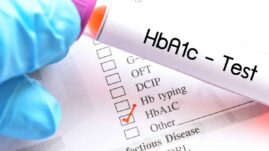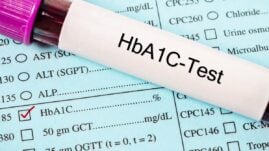This post may contain affiliate links. Please read our disclosure.
The A1c test, also known as glycated hemoglobin, hemoglobin A1c, or HbA1c, is essential for anyone living with diabetes.
While it doesn’t provide a complete picture of your diabetes management, it serves as an important indicator of whether your average blood glucose (sugar) levels are within a healthy range for you.
Today, I’ll guide you through the steps to measure your A1c easily and accurately at home.
We’ll also explore what the A1c test reveals, why it’s important, and how to understand the results.

Key facts
- The A1c test is a measure of average blood glucose control over the previous 2 to 3 months, with a recommended target generally below 7 percent for people living with diabetes.
- Routine monitoring of A1c levels helps manage diabetes effectively and avoid long-term complications.
- Home A1c test kits offer a convenient and accurate alternative to lab tests, delivering results within 5 minutes.
- While most health insurance plans cover lab-based A1c tests, coverage for at-home kits varies and should be verified with your insurance provider.
What is an A1c test?
The A1c test, a blood test, measures your average blood glucose levels over the past 2 to 3 months and is reported as a percentage. Typically, people without diabetes have an A1c below 5.7 percent.
This test serves as a valuable tool for diagnosing diabetes and evaluating the effectiveness of your diabetes management strategy.
The ADA provides the following guidelines for using the A1c test in diagnosing diabetes in nonpregnant:
| A1c Level | What It Means |
| Less than 5.7 percent | Normal |
| 5.7 percent to 6.4 percent | Prediabetes, meaning at increased risk for developing type 2 diabetes |
| 6.5 percent or greater | Diagnosed diabetes (with a second result for confirmation) |
The ADA recommends that many non-pregnant people with diabetes aim for an A1c of 7 percent or lower, which corresponds to an average blood sugar level of roughly 154 mg/dL (8.6 mmol/L).
Learn more in: How to Translate Your A1c to a Blood Sugar Level.
While some may target A1c levels closer to the normal range, it is crucial to avoid overly aggressive reductions that can lead to dangerous hypoglycemia (low blood sugar).
It’s important to personalize your A1c target in consultation with your healthcare provider, allowing adjustments as needed to suit your health needs and lifestyle.
Why is it important to measure your A1c
Monitoring your A1c is important as elevated blood sugars can lead to numerous short- and long-term diabetes complications. Keeping your A1c at a healthy level helps reduce these risks.
If your A1c levels begin to go above your target, you can take several steps to lower them, such as adjusting your medication with your healthcare provider’s guidance, altering your diet, increasing your physical activity, and making other lifestyle changes.
Read more in: How to Lower Your A1c: The Complete Guide.
Since the A1c test provides a snapshot of your average blood sugar levels over the last 2 to 3 months, it’s recommended to measure your A1c at least quarterly in people newly diagnosed and/or whose glucose levels are consistently above their target range.
This regular monitoring helps you track the effectiveness of your diabetes management strategies.
“I feel like I’m healthier now than I have been in decades. I’m exercising more and making more conscious diet choices.”
-Wes Moran (you can read how Wes lowered her A1c here)
For those who have steady glucose levels within their target, A1c testing may be recommended at least twice a year.
How to use the A1c home test kit
Measuring your A1c at home can be beneficial for several reasons, including limited access to see your healthcare provider, the distance to a lab, or the cost of lab work.
While there are several excellent options for home A1c testing at home, it is important to consult with your medical team before making any changes to your diabetes care or attempting to diagnose yourself.
One cost-effective option is the CVS A1C At Home Test Kit, which I demonstrate in the video below. This kit can deliver your A1c results on the spot in just 5 minutes.
A1c home test kit general instructions
Although exact instructions vary from kit to kit, general guidelines are as follows:
- Prepare your testing area by laying out all necessary equipment in a clean and dry area.
- Ensure your hands are clean for the procedure. You can wash them thoroughly with soap and water and dry them completely, or use an alcohol prep pad and wait for the alcohol to dry.
- Use the lancet on the side of your fingertip to minimize discomfort (avoid the fingertip pad as it may be more painful), and gently press to produce a small drop of blood.
- Position the blood collector against the blood drop, letting it absorb enough blood as specified by the manufacturer’s instructions.
- Attach the filled blood collector to the shaker device, secure it, and then shake vigorously for about 5 to 8 seconds to mix the sample with the solution.
- Open the test cartridge, insert it into the A1c analyzer, and use the base of the shaker to transfer the solution into the analyzer as directed. Once done, remove the base.
- Allow the device to process the results, which typically takes about 5 minutes. Avoid handling the analyzer during this time to ensure accuracy.
- Record your A1c result along with the date.
- Properly dispose of the used test cartridge and retain the analyzer for future use.
To ensure accuracy, follow the instructions included with your kit carefully and provide enough blood for the test, as insufficient samples may lead to errors.
Consider reading through the kit instructions prior to beginning the test to familiarize yourself with the steps. Also be sure to check the expiration date on your kit and store it according to the manufacturer’s instructions.
Are home A1c test kits accurate?
Home A1c test kits are generally considered to be as accurate as those performed in laboratories. Typically, these kits provide results with a precision of plus or minus 0.5 percentage points, which is about the same as most standard lab tests.
For guaranteed accuracy, it’s important to select kits that are NGSP-certified (National Glycohemoglobin Standardization Program), which ensures they meet rigorous testing standards similar to those used in professional laboratories.
Additionally, look for kits that have U.S. Food and Drug Administration (FDA) clearance or carry the Conformité Européenne (CE) mark.
FDA clearance indicates that the product has been assessed and deemed safe and effective for use in the United States, while the CE mark shows compliance with health and safety standards within the European Economic Area.
These certifications help ensure that the products meet rigorous health, safety, and environmental protection standards.
In my own experience using the A1CNow SelfCheck at home — demonstrated in the video above — the results matched perfectly with those from a lab test conducted at Quest Diagnostics just a few days prior. At least in my case, this confirms the reliability to me of certified home testing kits in real-world conditions.
How much does an A1c test kit cost?
The CVS A1C At Home Test Kit kit costs $52.79 on Amazon for a kit containing two tests as of December 2024. This was the most affordable option I found, though prices for similar home A1c kits on Amazon generally range from $60 to $100. (Prices for kits containing a single test can be as low as about $35.)
Home A1c kits are also available at major pharmacies like CVS and Walmart.
Additionally, there are kits that require you to collect a blood sample and send it to a lab. These kits necessitate collecting more blood (four to five large droplets) and may involve a wait time of up to 4 weeks for results, depending on mail speeds to and from the lab, as I have experienced.
Is it covered by insurance?
Most health insurance plans, including private and government plans, typically cover blood work prescribed by your doctor and conducted in a laboratory.
However, coverage for at-home A1c test kits is less certain unless the kit is specifically prescribed by a healthcare provider.
To determine if your plan covers these at-home kits, you should contact your insurance company or review your plan’s benefits. If covered, your insurer may recommend a preferred brand or specify a process for obtaining your kit.
Did you find this article helpful? Click Yes or No below to let us know!






Richard Niederberg
Which health care plans will provide the A1c monitor for their members? Private? Medicare? Medicaid? Etc?
Christel Oerum, MS
I don’t know if any of them will. Most cover at least part of the test if you get it done through your doctors office.
Sarah
This article has really helped me tremendously. I was getting tired of all the different things people are promoting out there as if there is no danger whatsoever with this disease! Thankfully I am not diabetic but such test results like what you discussed can freak out people who are reading trying to take care of themselves! I never heard of the range that labs give when trying to account for simple errors, sure makes a difference and how happy I am knowing I’m on the right track ! Thanks for listening to me and I’ve copied your article as it’s the best one yet I’ve uncovered.
art
where is the darn video? so much talk about this and that and you keep saying, see my video. where is it????
Tobias Oerum
It’s under the heading “how to use an A1C kit at home” at the end of that section. If you don’t see it, it’s because your browser won’t show it. It happens sometimes and we don’t know why yet. You can also watch a longer version of the video on YouTube: https://www.youtube.com/watch?v=5UYYB1L90pY&t=5s
Liz
Hi. I was diagnosed in April with prediabetes. My A1C was 5.7. I totally freaked out at first and ate nothing but salad and tested my A1C a month later and was down to five point two. But I knew I couldn’t keep living with on just salads and so I joined a Facebook group that follows the whole plate method which is females eat 30 to 45 good carbs per meal. Now before I was diagnosed I was 5’2, 118 lb, ate white pasta frequently, and certainly not a single serving size, more than one serving size, chocolates, bagels etc. I’ve been on the whole plate method, I have lost 15 lb, only eat 100% whole wheat or whole grain foods, 1/2 cup of brown rice pasta if I decide to have pasta. I occasionally will have a piece of 85% dark chocolate. I do an at home A1C test usually about every 6 weeks. My numbers go up and down from 5.5 to 5.7 etc. 2 weeks ago I tested my level and it was at 5.7. 3 days later my doctor scheduled me for lab work and my A1C was 6.0. I know that you said the test could be off by .5, but it’s really freaking me out because I don’t know if I’m doing better or getting worse. Plus I can’t understand how over the last 51 years of my life, I ate whatever I wanted and I got diagnosed as pre-diabetic at 5.7 and now that I’m eating very carefully, I’m still at 5.7 or higher. There is diabetes in my family, on both sides but I guess I just don’t understand how now that I’m eating better than ever before and I’m down to just over 100 lb my number hasn’t gone down as well. Any insight into this?
Christel Oerum
Our bodies change over time and this might just be a reflection of that change. But I would ask your doctor for an antibody test as well as a c-peptide test. Your A1c is still low, but you might not be producing enough insulin (insulin deficient) rather than only being insulin resistant (read more here: https://diabetesstrong.com/is-type-2-diabetes-reversible/). If you’re insulin deficient, there’s really very little you can achieve through exercise and diet alone.
Susan
I thought I read an article here about which A1c home test kit is the best one to buy. It included one or several videos that followed the writers efforts to decide. She went to a lab for the final test and she is inside her car talking about it. She has a bandaid in the crook of her elbow. The first kit results matched the lab results. She got the kit results at home in a few minutes. The second test was another kit but she had to send the test away to get the results and they did not match the other two. I cannot find this article and videos anywhere. There is one article that references a video (below) and there is no link there. The same article further down references a video (above) and there is no link above. So whatever the video was, its link is gone. The video may not have been what i was looking fo anyway. Was or is this article and video links on this site?
Christel Oerum
Hi Susan, I only have the video on YouTube, here you go https://youtu.be/5UYYB1L90pY
Susan B
Hi Chrystel – I got the home self-test and tried it. I messed up the first time despite following the instructions and your video so I called the company for help and then tried again. It worked, and A1c is 6.3. I was kind of disappointed because it was 5.5 last time and I want this peripheral neuropathy to go away. It is pretty bad and affects my sleeping and walking. It is getting better but has a long way to go, so I want that A1c in the normal range until the neuropathy is the best it can be, and after that 6.3 would be fine with me – it allows a few more units of insulin and more snacks. I did reduce insulin to try and lose about 10 of the 30 pounds I gained on insulin, in spite of a very very careful diet, so that is the reason the A1c went up. I am learning as I go. This is my first year after diagnosis. I realize everyone says A1c of 6 to 7 is fine. It just isn’t fine with me. Anyway, thanks for the video, your great articles and everything I’ve learned.
Charlie K
Liz I was exactly the same, able to eat whatever I wanted and then right about your age it was like something just broke. I’ve heard other people say this too. I wasn’t diabetic and then bam, I was diabetic. Weird.
AI
The accuracy is +/- 5%. That equates to roughly +/- 0.03 for a measurement of 5.7.
Alex Urich
Well, 5% of 6 is not 0.03 but 0.3. So, an A1c of 6.0 could be a 5.7 or a 6.3 which makes a big difference. Even worse if your reading is 6.5, you’re either pre-diabetic with 6.2 or full diabetic with 6.8. I always thought that is absolutely ridiculous to diagnose such a formidable disease like diabetes based on a decimal number only. The +/- 0.3 could dramatically change your entire life. This A1c made the ENT doctor a very happy camper, no other tests are necessary. Go figure…
By the way, it is common practice for lab testing companies to add the instrument tolerance to the blood reading so a reported 6.0 is always 5.7.